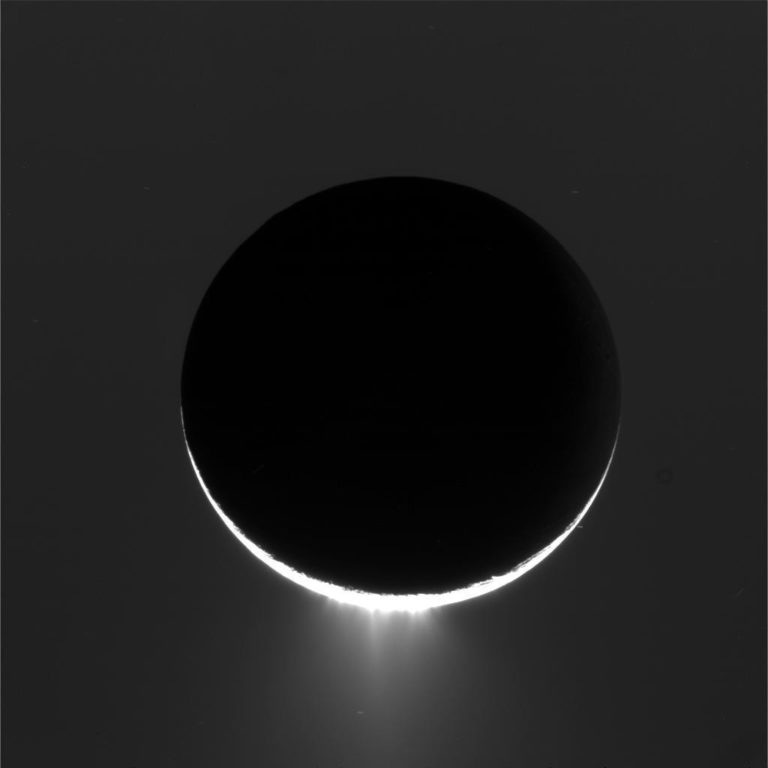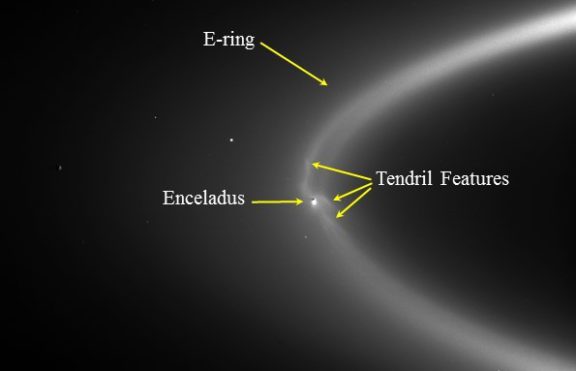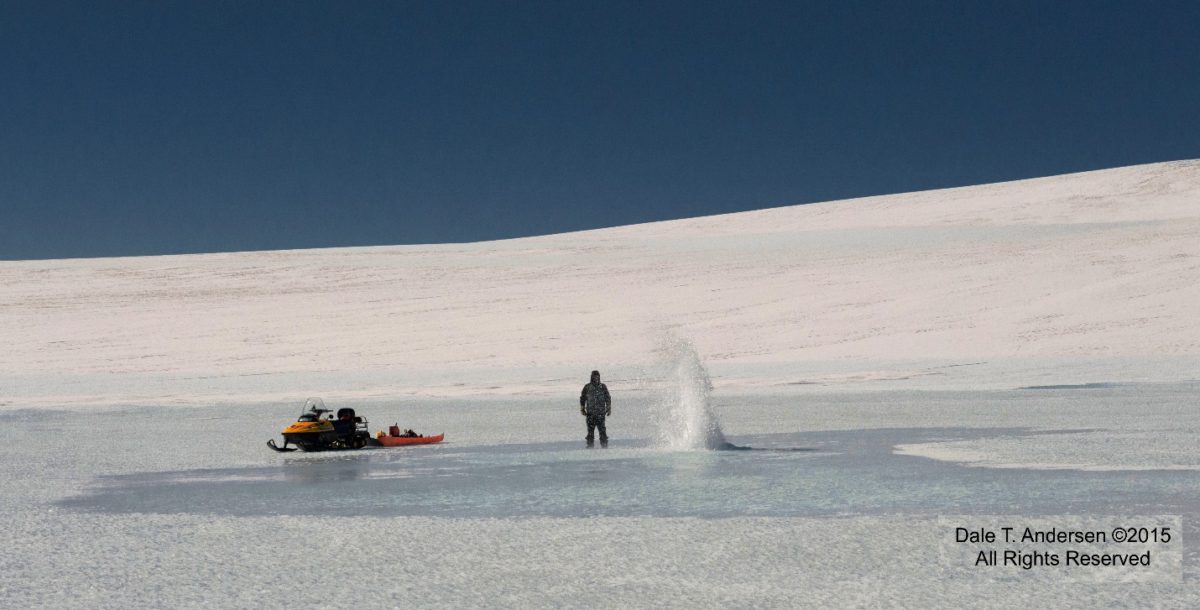Deepak Dhingra • Jan 22, 2015
Fountains of Water Vapor and Ice
Geysers of water vapor and ice particles shooting up to 200 kilometers into space from the surface of an ice ball roughly 500 kilometers across is quite an intriguing spectacle. What is actually happening? How is it happening? Is it happening elsewhere? Here I'm referring to the gigantic jets of Enceladus. These geysers are spewing material from Enceladus' deep interior, and therefore provide direct samples holding clues about the evolutionary history of icy bodies. I share here some of the latest research on these fountains presented at the American Geophysical Union (AGU) Fall Meeting in San Francisco last month.

It's been more than 9 years since Cassini first spotted water vapor/ice plumes at the south pole of Enceladus, Saturn’s fifth largest satellite. More recently, plumes have also been reported from Jupiter’s satellite Europa and the dwarf planet Ceres. Are they all similar in origin? Do they have similar compositions? How long they have been active? These are difficult questions to answer at the moment. However, the incredible amount of data on Enceladus’ plumes being returned by Cassini is currently our best shot at understanding these messengers from the deep interior. This sentiment was echoed at the AGU meeting, with Enceladus research dominating the plume-related sessions.
James Roberts and Angela Stickle from Johns Hopkins University Applied Physics Lab (JHU-APL) presented a scheme to enhance the tidal effects on Enceladus. They presented the idea of a rubble pile core (instead of a solid interior) with pore spaces filled with ice, arguing that such a setting will be more effective in producing geysers due to significant increase in the tidal forces. Otherwise, there does not seem to be sufficient heat available to sustain geyser activity for long. They also raised the question of why the current plume activity at Enceladus only occurs at south pole when the tidal effects are symmetrical—equally effective on the north and the south poles. They considered the role of an impact in initiating the plume activity. It was suggested that the impact event would melt significant amount of material, locally raise the temperature, and increase the effect of tidal flexing on Enceladus. Such an event could therefore aid in generating localized geyser activity. Impact-induced displacement of material might also explain the low topography observed at Enceladus' south pole.
The plumes of Enceladus have spun a weak halo along its orbit: the E-ring of Saturn. Colin Mitchell of the Space Science Institute and his colleagues made an interesting presentation where they synthetically reproduced sinuous patterns observed in E-ring called ‘tendril features’ in order to understand their origin and controlling factors.These tendril features can only be observed under very special observational conditions where Sun is completely blocked by Saturn while the spacecraft is making observations.

Their simulations showed that freshly launched particles from specific plume sources generate a specific tendril feature, indicating that different plume sources are active at different times. Colin showed an example where a particular tendril feature could only be produced when he ‘switched-off’ a set of sources amongst the 36 plume sources that he used in the simulations. This is an important piece of information in understanding how the plumes are currently operating at Enceladus. Several parameters went into the sophisticated simulations, including the gravity of Saturn and Enceladus, the intense magnetic and electric fields of Saturn, and solar UV light, which continuously interact with the plume particles generated by Enceladus. Another cool result was that the leading and trailing tendrils (with respect to Enceladus’ motion) were dominated by particles of different sizes!
Looking at the mesmerizing images of Enceladus’ plumes makes one wonder if we could one day land a probe on Enceladus and see these gigantic geysers up close...after all, there is no replacement for making ground-based observations. While a mission to Enceladus may be at least a decade or two away, terrestrial analogs (similar settings on Earth) are great opportunities to explore what might be out there, especially when it comes to exploring the possibility of life. Terrestrial analogs also hold incredible value in mission planning and testing methodologies. You may be wondering if there are really gigantic ice/water fountains on Earth like Enceladus—the simple answer is "No." However, there are environments on Earth that share similarities with Enceladus and can therefore be explored to aid in our understanding of what's happening on (and in) the icy satellite.
Alison Murray from the Desert Research Institute and her colleagues highlighted the potential of two Enceladus analogs in Antarctica: Lake Untersee and Lake Vida. These lakes are sealed with a thick ice cover, have unexplained energy sources, and one of them exhibits a gas saturated, water-based plume. The two lakes provide two different environments that may share similarities with the sub-surface ocean at Enceladus. Lake Untersee is characterized by very low nutrient levels, photosynthetic microbial mats, and other micro-organisms in the sediments and water column. It also has high levels of dissolved methane deep within one of its two basins. Lake Vida has the thickest ice cover amongst lakes on the Earth. It has abundant inorganic and organic nutrients and is known to support a consortia of microbial life, despite the frigid -13.4°C temperature that is stable below 16 meters. The ice-bound lake has only trace amounts of methane but shows evidence of salt solutions (brines) associated with ice—something that could also be a possibility at Enceladus. Although both lakes are sealed with ice year-round, there's quite a contrast in their character, providing an opportunity to study at least two possible ecosystems under conditions similar to Enceladus.

There are several unanswered questions related to Enceladus' subsurface ocean where such analog studies can help. One of the fundamental questions relates to how oxidation or reduction processes occur in such cold systems and whether there is any preference. This is important because some of these processes lead to release of energy, which is an important parameter to consider in exploring habitability. Other questions are related to interaction of water with rock under such conditions, and the interaction of water with ice. Both of these interactions are expected to happen on Enceladus and would determine the composition of both its subsurface ocean and what erupts at the surface as plumes. Since Cassini has been tasting the composition of the plumes through its sensors, with the analog studies we can build a bottom-up approach (use Antarctic lake interior composition to predict plume signatures on the surface) and compare that with a top-down view from Cassini (use plume composition to track down the composition of the subsurface ocean).
And if you're wondering how we can observe and measure the plume characteristics at the Antarctic lakes, we can simply create plumes by drilling through the ice! Since the lakes are sealed with a thick ice cover that continually traps and concentrates air bubbles released by the glaciers that dam them, they are similar to a pressurized can that fizzles out when punctured. Murray’s colleague Dale Andersen at the SETI Institute leads the research being carried out at lakes Obersee and Untersee and has observed plumes at these lakes after they were penetrated with ice drills. Although we'll have to wait for awhile to get a view of the plumes of Enceladus from the ground, the spectacle of artificially-generated plumes in similar environments on Earth—and the prospect of detecting the signatures of life within them—is a good start.

Let’s Go Beyond The Horizon
Every success in space exploration is the result of the community of space enthusiasts, like you, who believe it is important. You can help usher in the next great era of space exploration with your gift today.
Donate Today

 Explore Worlds
Explore Worlds Find Life
Find Life Defend Earth
Defend Earth

